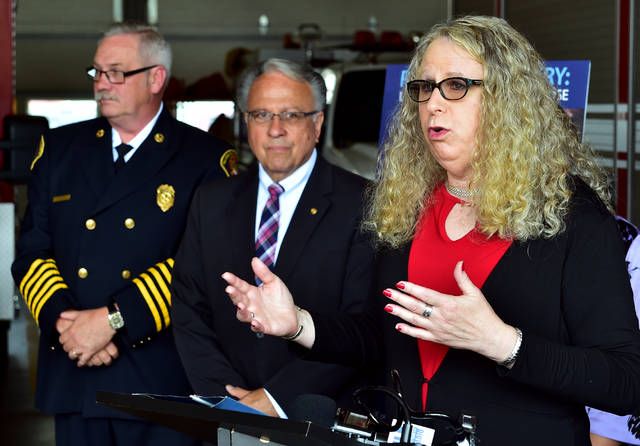Click here to subscribe today or Login.
WILKES-BARRE — First responders were called to help a person Friday morning who was on the verge of becoming just another statistic — until an opioid-reversal drug saved the day.
The incident occurred just hours before acting Secretary of Health and state Physician General Dr. Rachel Levine visited Wilkes-Barre City Fire Department headquarters to emphasize the importance of putting Naloxone in the hands of first responders and the public to save lives in overdoses from heroin and other opioids.
Deputy Fire Chief Alan Klapat said the drug worked to reverse Friday’s overdose, but first responders didn’t administer it. Someone else did who had obtained the drug through orders Levine signed in 2015 making it available to the public without first obtaining permission from a doctor.
“A friend or acquaintance had the standing prescription and administered it,” Klapat said.
“We arrived on scene. We assessed the patient. The patient was conscious and alert. They didn’t want to go to the hospital,” Klapat said. He did not have all the details, but said the patient’s release was cleared through the proper officials.
First responders have saved more than 3,800 lives in the past two-and-a-half years since Levine signed an order that allowed police, firefighters and first responders to carry the drug, also known as Narcan. But the recent incident also points to the effectiveness of allowing people to buy the prescription drug that costs approximately $40 a dose at pharmacies on their own.
“We want friends and family to have Naloxone available in case their loved one suffers from the disease of addiction,” Levine said.
The state wants to help first responders buy the drug through a $5 million line item in Gov. Tom Wolf”s 2017-2018 budget. The timing is critical, Levine said, explaining the drug has a shelf life of approximately two years and much of what first responders obtained since 2015 is about to expire.
Acting Secretary of Drug and Alcohol Programs Jennifer Smith, who joined Levine at the fire station, noted there wasn’t such funding in previous budgets.
“It sounds like a lot ‘til you calculate it out and realize that there are 67 counties here in Pennsylvania,” Smith said. The state is still working out the details on how the opioid antidote would be distributed.
“Initially, it will be a little bit of formula-driven, but with the flexibility to then alter that from the usage being reported by the counties,” Smith said.
‘All hands on deck’
During the first half of this year, the fire department and emergency services administered more than 200 doses of the antidote, said Wilkes-Barre City Fire Department Chief Jay Delaney. That’s not counting what the police department did, he said.
The fire department has relied on $15,000 in donations this year and the same amount last year to buy the drug, Delaney said. He was reluctant to disclose the source of the money. “It has been non-city funding, if I can put it that way,” said the chief.
He was not alone in describing the opioid epidemic as unlike anything he has seen in his 37 years in public safety.
“This issue is all hands on deck. That’s why I’m calling it a state of emergency,” said state Rep. Eddie Day Pashinski, D-Wilkes-Barre.
A study released Thursday by the Philadelphia division of the U.S. Drug Enforcement Administration and the University of Pittsburgh reported 4,642 drug-related overdose deaths last year in the state. That translates into approximately 13 deaths daily. Of the total, 85 percent had the presence of illicit or prescribed opioids. Luzerne County ranked 13th statewide with 140 overdose deaths last year compared to 95 in 2015. Of the total for last year, 67 were connected to the painkiller fentanyl and 50 to heroin, both opioids.
Besides the funding for Naloxone, legislators are struggling to create laws to provide the next needed steps for treatment and recovery, Pashinski said.
The state has established a “Warm Handoff” protocol for overdose patients admitted to hospital emergency departments. Secretary Smith said it attempts to get patients into treatment rather than releasing them back onto the streets. With the consent of a patient, the emergency department would contact the designated authority in the county for drug and alcohol treatment to meet the patient in the hospital.
“Then they’ll do an assessment and they’ll talk with the individual, give them resources if they’re not willing to go to treatment,” Smith said. “If they’re willing to go to treatment, they’ll stay with them and they’ll arrange transportation.”
Chief Delaney agreed Naloxone is just a part of the overall plan of attack.
Delaney said most of the people who are treated with Naloxone are mad afterward. “And I look them between the eyes and I say, ‘You were two minutes away from death. You don’t realize it, two minutes away from leaving this earth.’”
“We’ve had some twice in the same day,” Delaney said. “But as you heard in my talk, I think part of the equation is getting them inpatient treatment so that they can get permanent help and assistance.”





